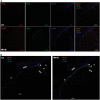Elevated adult neurogenesis in brain subventricular zone following in vivo manganese exposure: roles of copper and DMT1
- PMID: 25575534
- PMCID: PMC4306725
- DOI: 10.1093/toxsci/kfu249
Elevated adult neurogenesis in brain subventricular zone following in vivo manganese exposure: roles of copper and DMT1
Abstract
The brain subventricular zone (SVZ) is a source of neural precursor cells; these cells travel along the rostral migratory stream (RMS) to destination areas in the process of adult neurogenesis. Recent x-ray fluorescence (XRF) studies reveal an extensive accumulation of copper (Cu) in the SVZ. Earlier human and animal studies also suggest an altered Cu homeostasis after manganese (Mn) exposure. This study was designed to test the hypothesis that Mn exposure by acting on the divalent metal transporter-1 (DMT1) altered Cu levels in SVZ and RMS, thereby affecting adult neurogenesis. Adult rats received intraperitoneal (i.p.) injections of 6 mg Mn/kg as MnCl2 once daily for 4 weeks with concomitant injections of bromodeoxyuridine (BrdU) for 5 days in the last week. In control rats, Cu levels were significantly higher in the SVZ than other brain regions examined. Mn exposure significantly reduced Cu concentrations in the SVZ (P < 0.01). Immunohistochemical data showed that in vivo Mn exposure significantly increased numbers of BrdU(+) cells, which were accompanied with increased GFAP(+) astrocytic stem cells and DCX(+) neuroblasts in SVZ and RMS. Quantitative RT-PCR and Western blot confirmed the increased expression of DMT1 in SVZ following in vivo Mn exposure, which contributed to Mn accumulation in the neurogenesis pathway. Taken together, these results indicate a clear disruptive effect of Mn on adult neurogenesis; the effect appears due partly to Mn induction of DMT1 and its interference with cellular Cu regulation in SVZ and RMS. The future research directions based on these observations are also discussed.
Keywords: adult neurogenesis; copper; divalent metal transporter-1; manganese; rostral migratory stream; subventricular zone.
© The Author 2015. Published by Oxford University Press on behalf of the Society of Toxicology. All rights reserved. For Permissions, please e-mail: journals.permissions@oup.com.
Figures












Comment in
-
From the Editor's Desk, Editor's Highlights, Letters to the Editor.Toxicol Sci. 2016 Aug;152(2):257-61. doi: 10.1093/toxsci/kfw113. Toxicol Sci. 2016. PMID: 27462124 Free PMC article. No abstract available.
References
-
- Andrews N. C. (1999). The iron transporter DMT1. Int. J. Biochem. Cell Biol. 31, 991–994. - PubMed
-
- Barnham K. J., Bush A. I. (2008). Metals in Alzheimer’s and Parkinson’s diseases. Curr. Opin. Chem. Biol. 12, 222–228. - PubMed
-
- Burdo J. R., Menzies S. L., Simpson I. A., Garrick L. M., Garrick M. D., Dolan K. G., Haile D. J., Beard J. L., Connor J. R. (2001). Distribution of divalent metal transporter 1 and metal transport protein 1 in the normal and Belgrade rat. J. Neurosci. 66, 1198–1207. - PubMed
-
- Curtis M. A., Faull R. L. M., Eriksson P. S. (2007). The effect of neurodegenerative diseases on the subventricular zone. Nat. Rev. Neurosci. 8, 712–723. - PubMed
Publication types
MeSH terms
Substances
Grants and funding
LinkOut - more resources
Full Text Sources
Other Literature Sources
Miscellaneous

